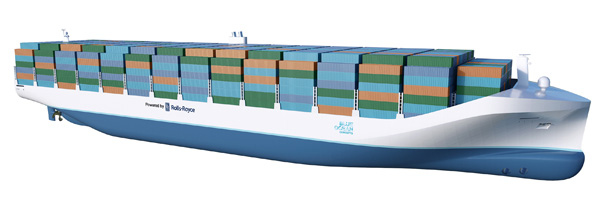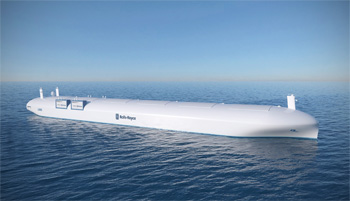Are the days of manned cargo ships numbered? Rolls-Royce thinks so and is aiming to have drone vessels on the water within 15 years, an initiative that has drawn skepticism from many in the maritime industry who question the safety of going crewless.
The London-based company has begun designing automated ships that it says will be more efficient and significantly cheaper to operate than their manned counterparts. Captains would guide the ships remotely from 360-degree “virtual” control rooms onshore, allowing one person to monitor and steer many vessels at the same time. Onboard personnel no longer would be required, removing the need for a bridge and the accommodation systems that add weight and expense to ocean voyages.
“The fact is if you don’t have people on board, then you don’t need any deckhouse,” said Oskar Levander, vice president of innovation in marine engineering and technology for Rolls-Royce. “And if you don’t have people on board, you don’t need a lot of systems that are there just for them. It’s about water production, it’s about heat and ventilation and provision storage, a lot of things that are there today to make it habitable for people. All that goes away with an unmanned ship. The weight comes down and there is a lot of cost that goes into building these systems.”
 |
|
An architect’s rendering of a containership that would operate without onboard personnel, based on a design by Rolls-Royce. |
With crew accommodation eliminated, the ship would have more room for cargo, contributing to efficiency. Fuel savings would vary depending on the ship type, with Rolls-Royce projecting a 15 percent cost reduction when comparing a standard bulk carrier to an unmanned one. Then an operator could subtract the expense of a crew. A 2011 report by industry consultant Moore Stephens LLP estimated crew supply and labor at 39 percent of the cost of operating a ship.
“The crew cost depends very much on your operation and size of vessel,” Levander said. “And it won’t go down to zero — you’ll still have some people involved in the remote control. But there are substantial savings. That is the driver. It is about making shipping more efficient.”
Levander said the savings could be achieved without sacrificing safety, adding that most maritime accidents are due to human error caused by fatigue or lack of concentration. The advent of drone vessels will not completely remove the human element, he said, but it will result in better conditions for those handling the ships.
“If you control the ship from land, the facilities are better,” Levander said. “People can go home to sleep; they have their family life. It’s a better working environment that should also provide for better concentration on work.”
The idea that an unmanned cargo ship could be safer than a crewed vessel doesn’t sit well with unions representing mariners. Critics see a ship controlled from shore via satellite as vulnerable to problems that inevitably arise while at sea.
“I don’t know about the technology aspect of it — I guess anything is possible nowadays — but from a practical standpoint I don’t see it as a tenable solution,” said Klaus Luhta, chief of staff for the International Organization of Masters, Mates & Pilots. “Just from a safety perspective, when you’re on a ship on the water, crossing the ocean, there are so many variables that go into how a vessel operates just in terms of navigation. A lot of those variables require real-time decisions that have to have a set of eyes on the problem.”
Levander said Rolls-Royce is designing its unmanned ships with redundant systems and with monitoring functions to anticipate equipment failures. If a shore-side operator were to lose contact with a ship, it would go into “safe mode” and stop where it is with the help of dynamic positioning. He said a ship could be programmed to drop anchor and wait for contact to be re-established.
While an unmanned ship far out at sea would typically be on autopilot — “you just supervise it,” Levander said — captains operating closer to port would use the 360-degree capability of the virtual bridge.
“You’re not limited to the view that you would have on the bridge of a ship,” he said. “When you look at many ships today, cargo ships, the bridge is quite far aft, it’s high up and you might have a lot of cargo in your view. You don’t see what’s really happening very close to the ship. So when you’re doing this with cameras and other navigational aids, you can get a much better picture.”
Luhta said the benefits of that technology fail to trump the need to have a captain and crew on board.
“I can’t envision a day when you have a video camera mounted in the wheelhouse looking out at the water, along with wind sensors and some sort of knot meter that reads the current, and be able to make decisions based on that data alone,” he said. “There’s kind of a feel to this business and you need people out there.”
Levander said Rolls-Royce is working to temper skepticism by getting the maritime industry acquainted with the concept far in advance. Unmanned vessels of this size are currently illegal.
“In order to create the market, we are now discussing it with flag states and class societies and trying to, so to speak, bring the different stakeholders into the game and drive this forward,” he said. “There are definitely shipowners who are interested in it. No one is saying they are going to buy it today because it is not there yet. But they definitely see it as a very interesting development and recognize that it will be one of the most fundamental changes in shipping for some time.”

